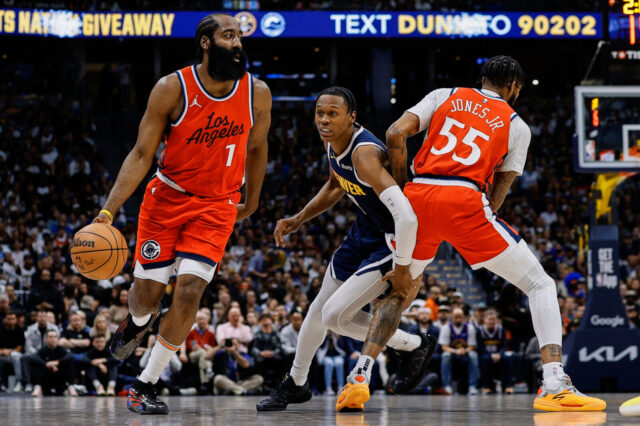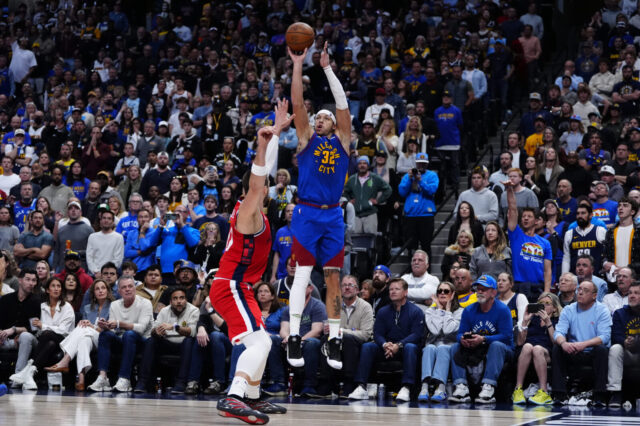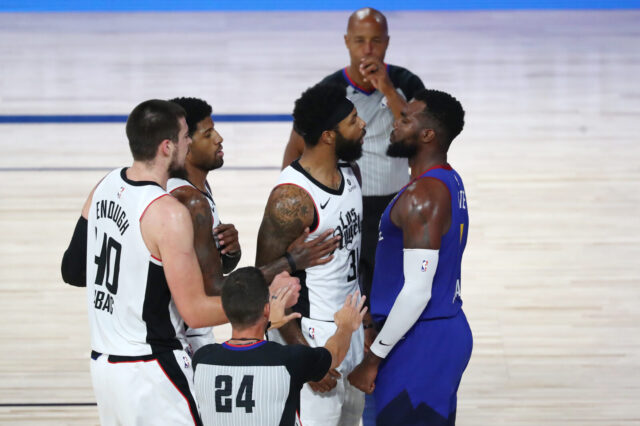The Denver Nuggets have, by most accounts, had a very successful offseason. They paid big money to retain their core, cleared some roster clutter, drafted for upside, and used their last few roster spots on either cheap young players or short term heavy-hitters. The direction of the franchise from a core player standpoint has been assured – so what comes next for a team that’s trying to shake the “pretender” label and become a contender?
There’s an experiment that shows what happens when you convert the elastic potential energy in several differently-sized balls to help boost the smallest ball much further than it would ever bounce on its own. It’s a cute experiment in momentum transfer, and how you can alter a process to deliver much bigger results without more investment of initial energy on the thing you’re trying to boost. There’s a reason the phrase “create momentum in business” returns 372,000 video results on Google: everyone wants to know how to get more returns on their investment without having to provide all of that energy themselves.
Financially, that sort of increase would look something like compound interest, where the interest built by an investment is then utilized long-term to generate far more wealth than simple interest alone. Bankers use a euphemism like, “putting your money to work for you” but it truly is creating a way for your initial investment to return far more than you invested.
Denver has struggled to build that momentum throughout its history. The Nuggets have labored in the shadow of the Denver Broncos for nearly their entire existence, with one of those teams going to title games and winning championships while the other was a first round playoff exit every year of Carmelo Anthony’s career in Denver but one. For a team with as many playoff appearances as Denver (two dozen in the NBA) they’ve certainly been snakebit whether by injuries, timing, payroll or just poor choices. One of those poor choices has been when to invest.
Denver is one of just three teams without an announced G League affiliate for the coming season. As teams announce and open sparkling new training facilities across the league, the Nuggets have been silent. And they keep losing assistant coaches to other teams while also running a smaller support staff of trainers and specialty coaches (like dedicated shooting coaches) than others as well.
Denver has instead been on a slow and steady upgrade path. They remodeled the locker room one year, put in a holographic projector and replaced some seats to enhance the fan experience another year, and this year so far they have given the practice court a face-lift.
Meanwhile this team is still forced to travel to the Olympic Training Center or Creighton University in order to hold training camp every year because their own facilities aren’t big enough. Other teams are investing 40 or 50 million dollars or more in the best and most cutting edge facilities money can buy, and Denver is getting left behind again.
This team is set up with core investments in players for the near future, but it is extremely hard to lure free agents to flyover country if all you’re offering them is a lukewarm meal in a lower-tier gym. The Utah Jazz know this – they’ve just finished their own state of the art facility. The Milwaukee Bucks have done the same thing. Once again Denver is at the back of the pack even when looking at teams in secondary markets that are also building young cores.
How can a $50 million investment in facilities return money to the Kroenkes? It works as both a free agent lure and to retain Denver’s home-grown talent, for starters. As strange as it sounds, max money actually tends to be worth it for superstars. Nikola Jokic is making $146 million over the next five years, but is projected to be worth $195 million in actual production by at least one source. That requires health, obviously, but that’s all the more reason to invest in facilities that keep him in peak condition.
Before the Phoenix Suns decided to go the cheap route, the Suns were renowned league-wide for their cutting edge medical and training staff that kept Steve Nash and Shaquille O’Neal healthy and on the court. That’s the sort of investment this team needs with new draft picks Michael Porter Jr and Jarred Vanderbilt being the latest in a long line of injury risks to don Nuggets uniforms. Their full recovery directly impacts Denver’s ceiling as a team as well as the price they have to pay lure to free agents instead of being able to stay in-house with their upgrades.
And as a team that just promoted both its two-way contract players to 15-man roster status, having a G League team would be a much more efficient way to get time for all these draft picks Denver is good at making but is struggling to find NBA minutes for. Instead of relying on another team to take care of the player development side of its own players, Denver could handle that business in house.
This really isn’t about a return on money, though. If Denver is serious about being a basketball team and not just an appreciating portfolio asset then the goal is not money but being a championship contender. That alone will bring more money and more opportunities. The Denver Nuggets are bursting with young talent that has huge ceilings both individually and collectively. They time is ripe to seize the momentum and transfer it from die-hard Nuggets fanatics to the city as a whole, and to build something that is both lasting and memorable. This chance doesn’t come along often. It came with Carmelo Anthony 15 years ago, and the Nuggets could not take full advantage. They had one Western Conference Finals appearance and then promptly sank back into the background muck of the NBA.
Momentum once lost is hard to recover. It requires a reinvestment of energy, and a plan for making the most of that momentum in order to make it easier to maintain. Newton’s First Law: an object in motion tends to remain in motion, while an object at rest tends to remain at rest. Denver has spent the past half-decade trying to recapture that momentum, and it’s past time to put the remainder of the plan in motion.
I expect to hear about training facility plans this summer. I expect to hear about G League plans. But I’ve expected to hear about them for the past two summers as well, and nothing has come to fruition. If the Nuggets are going to be last to the party then they also need to be in the lead pack when these plans are finally announced. This is not the time to quibble about the dollar size of the investment.
The Kroenkes are an incredibly rich ownership group, with far more cash on hand than Pat Bowlen who owns the Denver Broncos. Per Forbes, the Nuggets had a total operating income of $130 million in profit over the last six years even with a mostly-empty arena and abominable TV ratings. It’s time to re-invest. Josh is a baller who played at Missouri and happens to be from a billionaire family. Hopefully this is the year he announces that he’s putting his money where his heart is. And then maybe someday the Nuggets can put a quote like this on the wall of the new training center for the Denver Nuggets.
“I want us to be number one in everything.” – Pat Bowlen, owner of the Denver Broncos
That’s how you sustain momentum.


